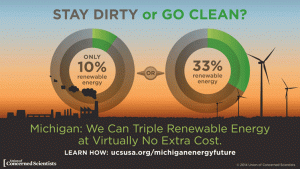Michigan and the Struggle to Provide Renewable Resources while Remaining Economically Viable
Written By: Polimana Joshevama
If you’re going to spend most of your time in your democracy figuring out how to get oil by intervening into other people’s countries and ensuring that you follow it with military might, we think there’s an alternative. Which would be renewable energy.
-Winona LaDuke
As Enbridge says, “Life takes Energy” (1). It takes energy to drive to work. It takes energy to build the chair you are sitting on. It takes energy to turn on your computer and read this blog post. There is no escape from the confines of this energy dependent society, but that does not mean the sources have to come from fossil fuels. The detriments of fossil fuels are a plague on our society that can be stopped by switching to sustainable energy alternatives like solar or wind.
Michigan has already taken steps towards switching to renewable energy sources by passing the Clean and Renewable Energy and Energy Waste Reduction Act in 2008 (2). This law required electricity providers to supply 10% of the state’s electricity with renewable energy sources, like wind and solar, by 2015 (3). With that nearly accomplished, the Union of Concerned Scientists came together to write a report strongly encouraging the State of Michigan to continue the trend and increase renewable energy sources to over 30%.
Switching to renewable energy sources is an economically viable way to phase out our society’s dependence on fossil fuels. The State of Michigan has in some ways realized this and in 2016 revised the Clean Energy Act referenced above, which now requires state electricity providers to generate 15% of their sales from renewable energy sources by 2021. This increased the demand for wind and solar power in the state, which allowed the market for renewable resources to expand, and also attracted several wind energy projects which now make up about 4% of all in-state electricity production. The promising switch allowed 1.2 million metric tons of carbon dioxide emissions to be avoided in 2016 (5). Although that is not enough to make a significant change in the United State’s carbon footprint, it is a start and an important one at that.
Solar power on an individual level and all the way up to federal policies is also a very effective way to reduce our carbon footprint, especially in the form of carbon dioxide. Total greenhouse gas emissions in 2015 for the United States came out to about 6,587 million metric tons of carbon dioxide, and 29% of those emissions came from the electricity sector where approximately 67% of our electricity comes from burning fossil fuels in the form of coal and natural gas (6). By reducing the sources of fossil fuels and increasing the number of renewable energy sources, there could be a drastic shift in how much electricity contributes to our carbon footprint, and our impact on climate change.
Line 5 is fueling three things according to Enbridge: communities, economies, and the oil and gas industry (7). Our communities, like Flint, are already suffering at the hand of fossil fuel companies. The oil and gas industry is replaceable by solar, wind, and other renewable energy sources. Capitalism profits the powerful, and they are not the ones affected by the oil spills, earthquakes from mining, or the polluted water sources. The fear of switching to renewable resources stems from the rich being afraid to lose their long-standing investments which were built by oppression. Oil money already has the blood of our ancestors on it, why does there have to be more? How long until Flint becomes more commonplace in cities? How long until all our water shines with oil rainbows? How long until you do something about it?
Notes
(1)https://www.enbridge.com/~/media/Enb/Documents/Factsheets/FS_WhoWeAre_LifeTakesEnergy.pdf?la=en
(2)http://www.legislature.mi.gov/documents/MCL/pdf/MCL-Act-295-of-2008.pdf
(3)https://www.ucsusa.org/clean_energy/smart-energy-solutions/increase-renewables/renewable-energy-in-michigan.html#.Wpc3IRPwZAY
(4)https://www.ucsusa.org/sites/default/files/legacy/assets/documents/clean_energy/Charting-Michigan-s-Renewable-Energy-Future.pdf
(5)http://awea.files.cms-plus.com/FileDownloads/pdfs/Michigan.pdf
(6)https://www.epa.gov/ghgemissions/sources-greenhouse-gas-emissions#t1fn2
(7)https://www.enbridge.com/~/media/Enb/Documents/Projects/line5/L5_ENB_HowDoesLine5BenefitMichigan_FactSheet.pdf?la=en
https://www.ucsusa.org/clean-energy/coal-and-other-fossil-fuels/hidden-cost-of-fossils#.Wpcw8hPwZAY
https://www.ucsusa.org/sites/default/files/legacy/assets/documents/clean_energy/Charting-Michigan-s-Renewable-Energy-Future.pdf

 (4)
(4) (6)
(6)